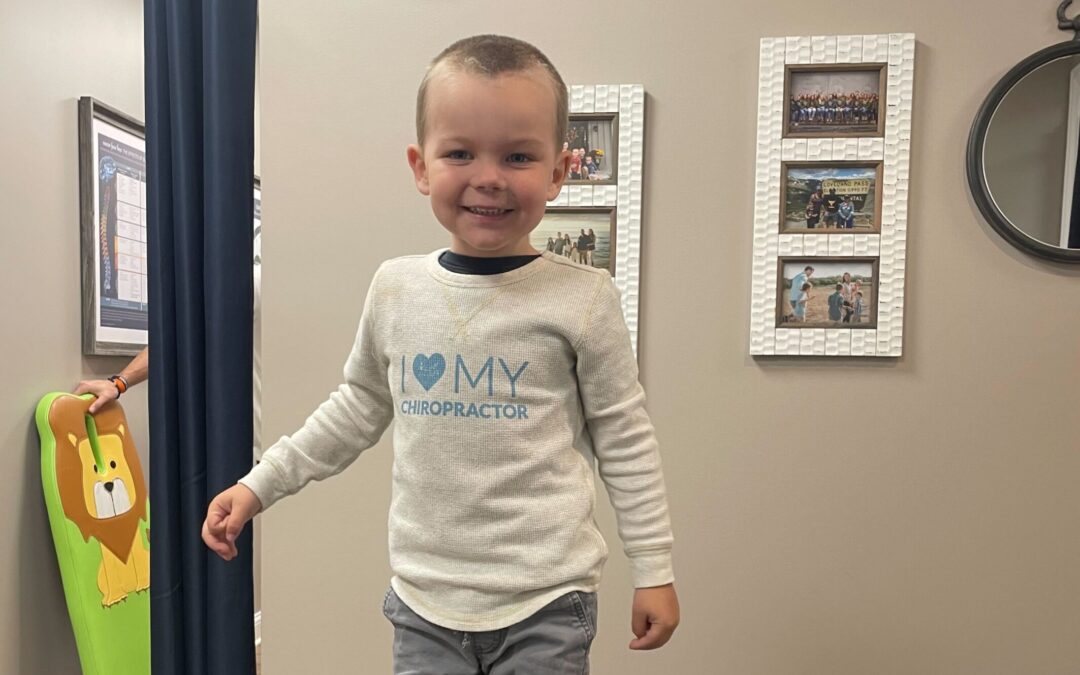There are so many emotions to navigate through when finding out you’re pregnant. Whether you have longed for a positive pregnancy test or this was a complete surprise, emotions and thoughts flow through your brain at what seems to be 1000 mph. “Is it a boy or girl?! How will my body do this? Who do I need to call and tell first?! How will we announce it on Instagram? What about the nursery? Will they go to private or public school? When do we start a college fund….???” It’s like everything starts to spin out of control and escalate. The list really does seem never-ending! And don’t get us started on the number of opinions and questions that start to flood in after telling people the good news!
Take a deep breath. Everything is going to be okay.
Let’s start with two of the most important questions to ask yourself first:
- “What kind of pregnancy do I want?”
- “Who is going to help me achieve that?”
In this article, we will explore what Prenatal Chiropractic is, the common (BUT NOT NORMAL) symptoms of pregnancy, and the available care options to create the healthiest human beings.
If you feel like you’ve heard so many opinions and options and are running like a chicken with your head cut off, trying to find where to turn to for answers and help during your pregnancy, then this article is for you!
What is Prenatal Chiropractic?
Prenatal Chiropractic Care is a specialized form of chiropractic that encompasses two (2) different elements that greatly benefit both mom and baby on this incredible journey:
- We provide safe, gentle, and effective adjustments that help mom’s nervous system better relax and make room for the growing baby, and keep mom strong and ready for a natural birth and optimal transition to motherhood
- Our office also provides an incredibly empowering and supportive environment where expecting moms and dads can ask the tough questions, access incredible resources, and feel confident throughout their journey
Taking it one step further, the kind of chiropractic care we provide within the PX Docs Network goes beyond just typical structural-based chiropractic care and focuses entirely on mom’s nervous system.
The umbilical cord connecting that developing baby to mom is not just there to carry oxygen and nutrients, but it’s also the neurological “power cord” that connects mom’s nervous system to her baby’s. In today’s world, where we have more stress, tension, and anxiety than ever before, the Neurologically-Focused Prenatal Chiropractic Care that we offer, therefore acts as a crucial component of keeping both mom and baby’s nervous system healthy, calm, and clear of interference all along the way!
What are the Common Health Challenges Faced During Pregnancy?
During pregnancy, a woman’s body undergoes significant changes, neurologically, hormonally, and physically, to accommodate the growing baby. These changes can lead to various hormonal changes, nervous system imbalances, and neuromuscular issues. There are many symptoms that commonly come along with pregnancy. From the early stages of morning sickness and fatigue to the annoying struggles of reflux, heartburn, trouble breathing, and the body changes, such as lower back pain, pelvic discomfort, and postural imbalances. All of these are very common during pregnancy, but are they normal?
What Causes All of These Pregnancy-Related Health Challenges?
This may seem like a silly question. The obvious answer is that you are growing a brand new beautiful baby from scratch. A little more… Every. Single. Day. OF COURSE YOU’RE FATIGUED AND UNCOMFORTABLE! But let’s dive deeper into the root causes of what is really causing some of these symptoms and what we can do about it!
The Role of the Nervous System in Pregnancy
A regulated and well-balanced nervous system is of utmost importance during pregnancy, as it profoundly influences both the expectant mother’s health and the developing baby’s well-being. The nervous system acts as the master control center, coordinating and regulating all body functions, from basic physiological processes to complex hormonal interactions. And now your nervous system has to do “double” the job, controlling all of your bodily functions and baby’s too.
During pregnancy, the autonomic nervous system (ANS), which is responsible for involuntary actions, plays a crucial role. The ANS consists of two branches: the sympathetic nervous system (SNS) and the parasympathetic nervous system (PNS). The SNS is what comes to life when you are under duress and experiencing stress. You might have heard it referred to as fight or flight. The PNS is the branch that helps us calm down, relax, and function once again after the stress has passed. To learn more about the parasympathetic nervous system and the Vagus Nerve that controls and regulates most of it, check out this additional article here.
But this wildly important parasympathetic side of the nervous system is not just responsible for rest and relaxation; it’s in charge of growth and development as well, making it perhaps the single most important system to pay attention to during the prenatal period (and postpartum as well). If mom’s nervous system is not in optimal growth and development mode, how can baby’s be?
A well-regulated and optimally balanced nervous system is essential for both mom and baby’s optimal well-being. When the nervous system is in a state of balance, it promotes better hormonal regulation, blood flow, and immune function, creating an optimal environment for the baby’s growth and development. It also contributes to the mother’s overall well-being, reducing stress levels, promoting relaxation, and improving sleep quality.
The Role of Stress and Subluxation in Pregnancy
Unfortunately, an imbalanced or dysregulated nervous system can lead to various health challenges during pregnancy. High levels of stress and anxiety lead to constant activation of the SNS and can contribute to complications like elevated blood pressure, decreased blood flow to the placenta, and potential adverse effects on fetal development.
Experiencing occasional stress is as normal as it gets, but unfortunately, today, too many women experience moderate to high levels of stress far too often. And sadly, our current medicalized system of prenatal care only adds to that stress, fear, anxiety, and disempowerment, it seems, with each and every visit to the doctor, additional ultrasound or exam, and so forth.
This ongoing and overwhelming stress is called subluxation. When subluxation is present, the entire nervous system shifts into an excessive sympathetic dominant state, increasing the tension on not just the nerves and muscles but also organs, glands, digestive system, and more. It even leads to its own “perfect storm” vicious cycle where now stress and anxiety are increased once again, other health challenges and concerns set in, and more trouble brews as the pregnancy goes on.
This tension can exacerbate blood pressure issues, back pain and sciatica, neck pain and headaches, anxiety and nausea, hormonal imbalances, and even affect a baby’s position in the womb.
Drug-Free Care Options for Pregnancy-Related Health Challenges
Fortunately, there are care options available to help pregnant women manage their stress and greatly improve their quality of life while their bodies are adapting to these new changes.
Often by the time pregnant women learn about the things we just covered with subluxation and the nervous system, they have tried all of the medications, homeopathics, teas, nutrition hacks, and physical therapies for pregnancy symptoms like heartburn, reflux, morning sickness, and pelvic pain.
As most of these things are great, they aren’t fully addressing the root causes of pregnancy-related health challenges. If you want to tackle these issues head-on and not only reduce the symptoms and health challenges you’re experiencing but also optimize your entire body and nervous system throughout the pregnancy, then Neurologically-Focused Prenatal Chiropractic is perfect for you!
Can You Measure This Stress and Subluxation? Introducing HRV to Prenatal Care
It’s quite an exciting time to be at the forefront of Prenatal Care like we are within the PX Docs Network! In the past few years, we’ve not only seen more and more research prove how important neurological health is during the prenatal journey (for both mom and baby), but also, some incredible technology has been developed to help us track and measure your neurological health all along the way in just a matter of minutes!
This technology is called HRV, which stands for Heart Rate Variability, and it is an absolutely essential exam for all pregnant women to take on a regular basis because it provides valuable insights into the health and function of their autonomic nervous system (ANS) function and overall health during pregnancy.
As stated above, the ANS controls and regulates every vital function in the body, including heart rate, respiratory rate, digestion, and more. With “fight or flight” and “rest and relax” being the two main branches of the ANS, it’s important to track how it is functioning and whether things are out of balance or not.
HRV is a measure of the variation in time between consecutive heartbeats. A higher HRV indicates a more flexible and adaptable nervous system, which is associated with better overall health and resilience to stress during pregnancy. This also means reduced maternal stress, better sleep quality, improved cardiovascular health, and enhanced immune function. Additionally, maintaining a balanced ANS is essential for supporting proper blood flow to the placenta and optimal fetal development.
On the other hand, a lower HRV suggests an imbalanced or stressed ANS, which can lead to various health issues, commonly leading to a high-risk pregnancy.
Therefore any professionals working with pregnant women need to be using HRV technology as the foundation of their care protocols and programs, allowing them to not only establish a baseline at the onset of care but also to track and monitor progress via actual neurological change and improvement.
Measuring and tracking true Autonomic Nervous System and Vagus Nerve functions are, therefore, the foundation of our work as Prenatal PX Doctors. Each and every pregnant woman who walks into our offices first get an HRV test to measure their overall adaptability and parasympathetic or vagal nerve tone.
Below is an image with a series of three (3) HRV Scans performed on a pregnant woman throughout her pregnancy. The first scan on the far left shows the small white box way in the lower left quadrant of the HRV plot, indicating her parasympathetic nervous system and vagus nerve are both suppressed and shut down, allowing her sympathetic fight or flight system to run out of control.
Then as care progresses over the second and third trimester, you can see the white box move towards the center line and higher up towards the green circle, indicating that her subluxation and dysautonomia were vastly improved and her nervous system is now much calmer, balanced, and better regulated, which shows that she is more adaptable to the stressors of pregnancy and ready to conquer her birth!
In addition to HRV, we ALSO run two (2) additional tests, NeuroThermal and NeuroSensory EMG, to complete the overall INSiGHT Scans and neurological exam. Together these three (3) collective scans can function as a pregnancy test that actually looks beyond symptoms and dives deep into the nervous system and how prenatal chiropractic can help both mom and baby.
Once we have these incredible INSiGHT Scans done, we can then put together a fully customized and personalized Care Plan made uniquely for the pregnant woman’s corresponding trimester. Once care begins, each and every Neuro-Tonal Adjustment our doctors are trained to make is designed to address subluxation and dysautonomia directly.
By activating and stimulating the Vagus Nerve and Parasympathetic Nervous System repeatedly over a period of many weeks to months, we then start to see an incredible decrease in the sustained sympathetic storm so many pregnant women are stuck in.
The first improvements these women typically notice are with sleep, digestion, fewer aches and pains, less “pregnancy brain,” more energy, and more focus. From there, the brain and nervous system can get back on track developmentally, and benefit both mom and baby, leading to optimal development and baby positioning, which can result in a quicker birth, fewer interventions, more vaginal births, and can help seek to prevent The Perfect Storm.
HOW TO GET THE HELP YOU NEEDBeing pregnant can be one of the most rewarding, exciting, and joyous times of our lives. But it can also feel very scary and overwhelming. Just remember that you are not alone, and you have choices when it comes to the pregnancy that you want and to the type of healthcare that you want supporting you along the way.
The earlier you are able to optimize and improve your neurological function, the better your pregnancy and birth outcomes will be for both you and your baby.
The best place to start on this journey is with a consultation and HRV Test with your local PX Doctor. Check out our PX Docs Directory here and get scheduled for an empowering consultation, INSiGHT Scans, and HRV right away!
Remember, you are not alone in this pregnancy journey, and we’re on your team! Take the first step and find the doctor, the care, and the community you and your baby deserve.





